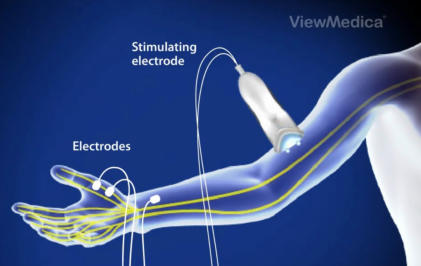
Copyright Southeastern Orthopaedic Specialists, P.A. All rights reserved.
Read our Legal Disclaimer. Web development by A Better Web, Inc.
Nerve Conduction Studies
Nerve conduction studies are often done along with an electromyogram to determine if a nerve is functioning normally. It may be recommended if you have symptoms of carpal tunnel syndrome or ulnar nerve entrapment. The doctor conducting the test will tape wires (electrodes) to the skin in various places along the nerve pathway. Then the doctor stimulates the nerve with an electric current. As the current travels down the nerve pathway, the electrodes placed along the way capture the signal and measure its speed. In healthy nerves, electrical signals can travel at speeds of up to 120 miles per hour. If the nerve is damaged, however, the signal will be slower and weaker. By stimulating the nerve at various places, the doctor can determine the specific site of the injury. Nerve conduction studies also may be used during treatment to test the progress being made. Although you may initially be startled by the suddenness of the stimulation, it is not usually painful and most people are comfortable during the testing procedure. The shock is similar to one received when you touch a doorknob after walking across carpeting. All Divisions of Southeastern Orthopaedic Specialists, P.A. have Board Certified Physical Medicine and Rehabilitation Physicians who are Interventional Specialists trained in the administration and interpretation of these studies.
Image courtesy of ViewMedica

Nerve Conduction Studies
Nerve conduction studies are often done along with an electromyogram to determine if a nerve is functioning normally. It may be recommended if you have symptoms of carpal tunnel syndrome or ulnar nerve entrapment. The doctor conducting the test will tape wires (electrodes) to the skin in various places along the nerve pathway. Then the doctor stimulates the nerve with an electric current. As the current travels down the nerve pathway, the electrodes placed along the way capture the signal and measure its speed. In healthy nerves, electrical signals can travel at speeds of up to 120 miles per hour. If the nerve is damaged, however, the signal will be slower and weaker. By stimulating the nerve at various places, the doctor can determine the specific site of the injury. Nerve conduction studies also may be used during treatment to test the progress being made. Although you may initially be startled by the suddenness of the stimulation, it is not usually painful and most people are comfortable during the testing procedure. The shock is similar to one received when you touch a doorknob after walking across carpeting. All Divisions of Southeastern Orthopaedic Specialists, P.A. have Board Certified Physical Medicine and Rehabilitation Physicians who are Interventional Specialists trained in the administration and interpretation of these studies.
Image courtesy of ViewMedica
Copyright
Southeastern Orthopaedic Specialists, P.A.
All rights reserved | Read our Legal Disclaimer
Web development by A Better Web, Inc.








![Close [x]](index_html_files/close.png)


































